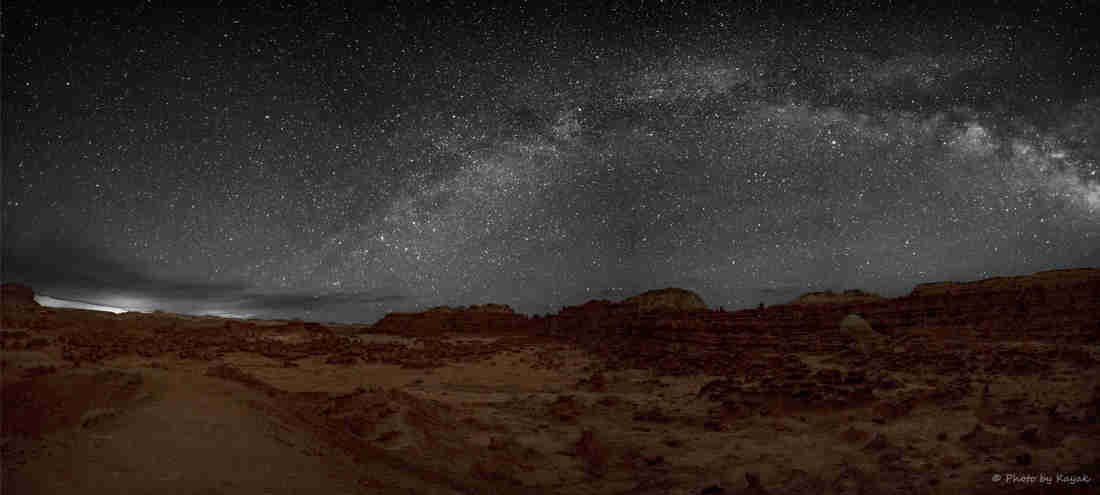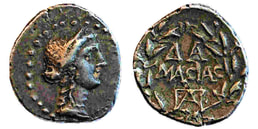|
Well, it is and it isn't. From Atlanta, where you can see about 150 stars in the night sky on a clear, moonless night, its about a three and half hour drive to the location where this photo was taken.
And, it's not a hard drive. You can get there mostly by interstate highway. Or, you can alter your route, as I do, and take State highways about half of thee way. This second route takes you through the Pisgah National Forest with beautiful woods, near roadside streams and waterfalls and through dozens of hairpin turns that will test out your four wheel drive. When you arrive you will also find a welcoming place to stay at the Pisgah Inn, nestled by itself next to the Parkway with a good restaurant and a million dollar view. The picture below shows the view from my room. That's the near perspective. In another sense, your three and half hour drive will take you billions of miles away. At least, if you venture out at night away from the lights of the Inn and look up and to the South and East. Then you will see our Milky Way stretched from horizon to horizon. The picture above shows the view early one morning in April from the first overlook south of the Pisgah Inn. How far are you seeing when you look above? The distance from our earth to the center of the Milky Way is about 8 kpc (kilo parsecs) or 166,000,000,000,000,000 miles (26,000 light years). Or, to think of it another way, when you look at the Milky Way you are seeing light generated more than 25,000 years ago. The Voyager spacecraft, which is traveling away from the Earth at a speed of about 10.7 miles per second, will take more than 450,000,000 years to get there. Would you like to look back tens of thousands of years or just see the sky the way our predecessors did before we lit our cities and towns to the point of washing out our local views of the sky? The "boldly go" and take a trip to the Parkway to see the stars. Photos by Kayak copyright Clinton Richardson. See more night sky images at the Night Lights Gallery of our TrekPic.com web site. If you like these posts, please tell your friends about the Venture Moola blog at Readjanus.com. And, feel free to share this blog. The more readers the better. Click here to subscribe to a weekly email that tells you when we issue new entries. Or, click in the column to the left to follow us on Facebook or Twitter. It's that time of year again. Prime season in the northern hemisphere for photographing the Milky Way in the night sky.
Beginning in late May and into August or September, the rotation of the earth makes the galactic core of the Milky Way visible north of the equator. In April, when this image was taken, the Milky Way arrives late into the night with only part of the core showing. This shot was taken just as dawn's glow was beginning to peek above the Eastern horizon. Later in the summer the Milky Way will rise earlier and stand more perpendicular in the sky. For now, though, it rises in an arch low in the sky before disappearing below the horizon. We were out all night last April to take this and several images, including one of the zodiacal light just after sunset. This image is a composite of 12 portrait style images stitched together to make one panorama. It's also edited to enhance the sky and the foreground. The camera sees more that the human eye in this low-light situation. The actual experience of standing in rural Utah away from all artificial light to watch and photograph the Milky Way cannot be easily described. While the photos are great and evocative of the experience, being out in the quiet (and cold this time) with thousands of visible stars above is an invigorating and humbling experience. This is the sky that we can no longer see from our aggressively lit cities and towns. This is the sky that until less than a lifetime ago, greeted people when they looked toward the sky. It is the sky of constellations that peoples around our planet believed housed their gods. It is the sky that inspired poets and provided clues for navigating our oceans. Today, we are lucky to see 150 stars in a typical urban or suburban area. To see it you have to travel to where human light pollution is less prevalent, which in this country means mostly out West but also in some more remote areas east of the Mississippi. If you do it once, you will probably want to do it again. It's invigorating and a bit disorienting at the same time to be out in the dark away from your comfort zone. You can easily get lost if you are not careful. And, working in the dark is different from working with adequate light. But, one thing for certain you will share an experience that came easily to your grandparents and great grandparents. And, you will be reminded of the vastness of the universe and our small place in it. By the way, when I mentioned editing the image did you notice that the sky is black and white while the foreground is in color. I admit to taking some license here but found making this change helps recreate some of the mood from the experience. Let me know if you like it. Images and text copyright Clinton Richardson. More night sky images at our TrekPic.com web site in the Night Lights Gallery. If you like these posts, please tell your friends about the Venture Moola blog at Readjanus.com. And, feel free to share this blog. The more readers the better. Click here to subscribe to a weekly email that tells you when we issue new entries. Or, click in the column to the left to follow us on Facebook or Twitter. As with many ancient coins, there is some debate about who is represented on the face of this coin issued in a part of Greece controlled by Marc Antony in the mid-30s BC during the Second Triumverate. Some believe the image of Aphrodite on the front is in the image of Cleopatra, Antony's lover, mother of his children and co-leader of his combined Roman and Egyptian armies and navies at the fateful battle of Actium.
The coin coin depicts the Greek goddess of love, beauty and procreation. It is believed to have been issued by Marc Antony and Cleopatra to pay their legions. The choice of Aphrodite for the coin would have been appropriate for a queen whose rise to power within a Roman man's world began while she was in exile fighting for her survival in Cyprus. This same island that launched Cleopatra onto the world stage also housed one of the two principal cult sites dedicated to Aphrodite and was believed by the Greeks to have been the birth site of the goddess. It is not hard to believe that the image was intended to honor the great queen who was worshiped as a goddess within her native Egypt. Most often she was portrayed as the Egyptian goddess Isis, who was worshiped as the ideal mother and wife, and goddess of children. A remarkable woman by any account, Cleopatra was the last of the Greek Ptolemy dynasty that ruled Egypt for 300 years. She ruled the wealthiest empire in the Western world with the most advanced arts, the most impressive cities, and the most luxurious lifestyles for its ruling class. She was also among the best educated rulers of her time, benefiting from being raised in a culture where women had more access to education than did their Roman counterparts. She could speak fluently in many languages and was the first Ptolemy able to speak to her Egyptian subjects in their native tongue. Cleopatra was at the height of her power when this coin was issued. With Marc Antony at her side, she had been proclaimed Queen of Kings and Queen of Egypt, an empire that included Egypt and much of the Levant and Greece. Her son Caesarion had been proclaimed by Antony to be the legitimate son and rightful heir of Julius Caesar. Would you like Marc Antony to send you a picture of Cleopatra, his co-ruler, lover and mother to his children? You can get this selfie and selfies from other ancient rulers by purchasing Ancient Selfies - History Revealed Through the World's First Social Media: Ancient Coins. Get the book in eBook or paper at Amazon.com or check out the book web site at at http://www.ancientselfies.com/. Details: Achaea, Patrae. Mid-30s BC. Silver hemidrachm. Obverse: Head of Aphrodite right wearing stephane, resembling Cleopatra? Reverse DA/MACIAC and monogram within wreath. 16 mm. 2.32 grams. References: BCD 525; SNG Copenhagen 154. Image and content copyright Clinton Richardson. Get Ancient Selfies in eBook or paper at Amazon.com or check out the Ancient Selfies web site at at http://www.ancientselfies.com/. If you like these posts, please tell your friends about the Venture Moola blog at Readjanus.com. And, feel free to share this blog. The more readers the better. Click here to subscribe to a weekly email that tells you when we issue new entries. Or, click in the column to the left to follow us on Facebook or Twitter. How would you like to receive a selfie from Julius Caesar or Cleopatra or Alexander the Great? Imagine how much more interesting the Romans and ancient Greeks would be if you could interact with them on social media. Imagine what you could experience and learn from seeing the selfies of leaders of the ancient world. Impossible you say? Romans did not have cell phones or the Internet. Heck, they did not even have soap. Social media is a modern phenomenon, right? Think again. The ancients invented the first social media and left their selfies for everyone to see. And these are not just ordinary selfies. They are engraved on the coins the ancients invented and used to distribute their images wherever their commerce took them. You can see them in Ancient Selfies, the 2017 International Book Awards Finalist in History that takes you back to ancient Greece, Persia and Rome in a new way - through the images commissioned by their rulers for their coins. For populations that were largely illiterate, these hand stamped coins made from hand engraved dies delivered images of their ancient rulers and the things that were happening in their lives. Their rulers understood the power coins had to communicate and used them to convey messages and shape impressions.
Thousands of years later, these very personal images enable us to travel back through the ages to get a unique glimpse into our past. The remarkably beautiful images on these coins, together with their stories, provide a unique and tangible way for us to connect directly with our past. For more about Ancient Selfies - History Revealed Through the World's First Social Media: Ancient Coins check out the Ancient Selfies web site at www.ancientselfies.com. Or, start with the readjanus.com/ancient-selfies.html page. Above image copyright Clinton Richardson is from the coin issued by Julius Caesar just days before his assassination. See the coin and read about Caesar in Chapter 4 of Ancient Selfies, available in color eBook and B&W print at Amazon.com. A version of this entry also appeared in the Ancient Selfies blog at ancientselfies.com/blog. If you like these posts, please tell your friends about the Venture Moola blog at Readjanus.com. And, feel free to share this blog. The more readers the better. Click here to subscribe to a weekly email that tells you when we issue new entries. Or, click in the column to the left to follow us on Facebook or Twitter. |
the blog
Travel, history, and business with original photos.
your hostClinton Richardson - author, photographer, business advisor, traveler. Categories
All
Archives
July 2023
Follow us on Facebook
|
Check out Ancient Selfies a 2017 International Book Awards Finalist in History and 2018 eLit Awards Gold Medal Winner and
Passports in his Underpants - A Planet Friendly Photo Safari a 2020 Readers' Favorite Winner in Nonfiction
Site Copyright 2024 by Clinton Richardson





 RSS Feed
RSS Feed